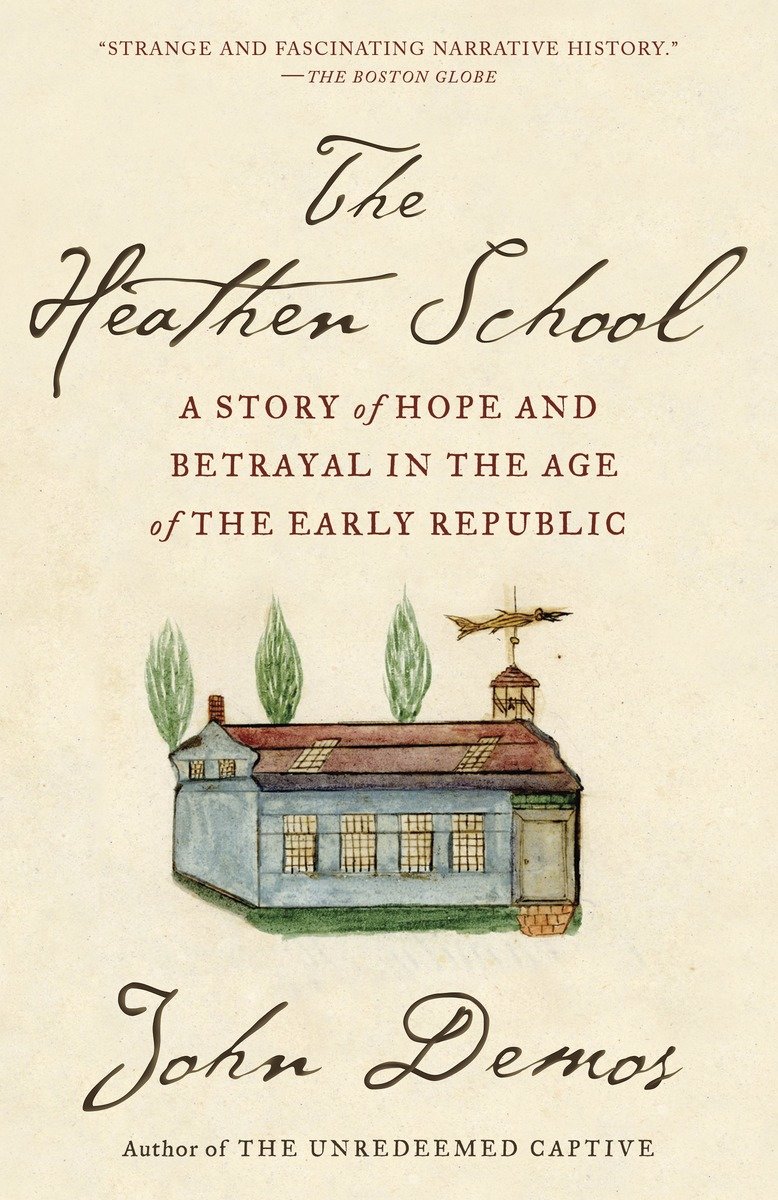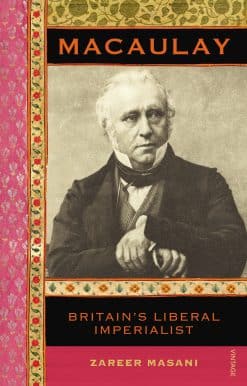A Story of Hope and Betrayal in the Age of the Early Republic: The Heathen School
17.95 JOD
Please allow 2 – 5 weeks for delivery of this item
Description
Award-winning historian John Demos tells the astonishing and moving story of a unique missionary project, which probes the very roots of American identity.Near the start of the nineteenth century, as the United States looked outward to the wider world, a group of eminent Protestant ministers devised a grand scheme for gathering the rest of mankind into the redemptive fold of Christianity and “civiization.” Its core element was a special school for “heathen youth” drawn from all parts of the earth, and, especially, the native nations of North America. If all went well, graduates would return to join similiar projects in their respective homelands.For some years, the school prospered, indeed became quite famous. However, when two Cherokee students courted and married local women public resolve and fundamental ideals were put to a severe test.
Additional information
| Weight | 0.30645 kg |
|---|---|
| Dimensions | 1.905 × 13.208 × 20.32 cm |
| by | |
| Format | Paperback |
| Language | |
| Publisher | |
| Year Published | 2014-12-2 |
| Imprint | |
| Publication City/Country | USA |
| ISBN 10 | 0679781129 |
| About The Author | John Demos is the Samuel Knight Professor Emeritus of History at Yale University. His previous books includeThe Unredeemed Captive, which won the Francis Parkman Prize and was a finalist for the National Book Award, and Entertaining Satan, which won the Bancroft Prize. He lives in Tyringham, MA. |
Praise for The Heathen School: A Story of Hope and Betrayal in the Age of the Early Republic:“Absorbing . . . considerable narrative skills are again on display . . . the men and women in his stories come alive across the centuries. . . . The book is peopled with a long cast of interesting characters—preachers, professors, philanthropists, missionaries, tribal chiefs.” —Melanie Kirkpatrick, The Wall Street Journal“Strange and fascinating narrative history . . . Demos gracefully interweaves the two couples’ stories with the historical and intellectual context in which they took place, raising key questions (especially, and devestatingly, ‘[m] not the heathen prefer to remain as they were?’).” —Kate Tuttle, The Boston Globe“Cornwall, a small community in northwestern Connecticut, would seem to have been an unlikely place to launch a campaign to save the world. But as John Demos recounts in this wonderfully crafted, deeply disturbing narrative, that is precisely what happened during the early decades of the 19th century. . . This splendid reconstruction of everyday life. . . Demos. . . describes what happened at Cornwall as a story of ‘high hopes, valiant effort, leading to eventual tragic defeat.’” —The American Scholar“Engrossing. . . . When John Demos came upon the story of the Heathen School, it was presented to him as mere local lore. But the seasoned historian recognized there was a lot going on in that little schoolhouse. It gave him a window into both the early 19th century evangelical movement as well as the shifting American attitudes toward racial mixing. . . . Demos intersperses his historical narrative with short personal essays of on-the-road reportage, in which he travels to Hawaii, where some of the school's most famous students hailed from, as well as to the Cherokee Nation home sites of the Boudinot and Ridge families. . . . The Heathen School is a provocative addition to recent narrative histories that explore how racial categories and attitudes have changed over time in America.” —Maureen Corrigan, NPR Books “I consider John Demos a superbly gifted scholar and writer . . . the appearance of this finely crafted, fascinating book can be a reason for celebration. Demos tells us how the story of a mission school in a small New England town connects to global events and major concepts of its era . . . this book demonstrates the power of historical narrative to illuminate ideas and issues that shaped the American past. . . . This tale is filled with surprises. . . . [The] larger historical lessons that John Demos provides make for absorbing reading.” —Clyde A. Milner II, The History Book Club“A complex account of a number of linked episodes in American history and their tragic aftermath. . . . It is in noticing countercurrents, complexities, and contradictions that Demos's greatness as a historian lies, and his consideration of all aspects of unfolding events shows to truly arresting effect in the rest of the story told here. . . . Such scrupulousness, erudition, and talent.” —B&N Review“John Demos . . . has gifted us with a historical opus. . . . The book is outstanding in many ways. Primary among them, it is beautifully written — the mixing of Demos’ craftsmanship and early melodious borrowed quotes . . . wonderfully executed impressions of his personal sojourns around today’s Cornwall and Hawaii. As the professor reminds us, The Heathen School was at one point ‘poised on the threshold of a new project, whose aim was nothing less than to save the world.’” —Barbara Hall, Providence Journal“Much-needed. . . . Demos shows how the founders’ dreams fell victim to racial bigotry within both the student body itself and in the greater Cornwell community. . . . This brilliant work is highly recommended.” —Library Journal (starred)“A poignant, well-researched historical vignette of how changing the world weighs on the individual shoulders bearing the task.” —Booklist“Demos, a Yale historian and master of micro-history (Bancroft and Parkman Prize winner for Unredeemed Captive), turns his attention here to a well-intentioned 1820s effort to create a Connecticut school to Christianize ‘heathens’ (mostly Indians and Hawaiians) and send them forth to missionize. . . . Demos tells this tall with scarcely hidden feeling. His research is characteristically prodigious, his writing disarming, and his story captivating and of national resonance.” —Publishers Weekly“Demos manages a sly, significant feat in this historical study/personal exploration. . . . In ‘interludes’ alternating with his historical narrative, Demos chronicles his visits to the places involved—e.g., Hawaii, Cornwall—in order to impart a personal commitment to this collective American tragedy. A slow-building saga that delivers a powerful final wallop.” —Kirkus (Starred Review)“No one knows early New England better than historian John Demos . . . he has used the letters, diaries and other documents of the era to bring whole towns and their leading characters virtually back to life, writing about them with a scholar’s precision, a storyteller’s imagination and, not least important, a large heart. . . . If one of Demos’ hallmarks as a writer is his subtle interpretations of his sources, another is his sensitive rendering of his subjects, almost always in their own words . . . the book is not only illuminating, it is, at times, positively gripping.” —Elinor Langer, The Oregonian “Demos . . . places the history of the Mission School in the context of quintessentially American optimism about the universal salvation and, alas, distinictively American racial intolerence . . . [a] textured account this utopian experiment in acculturation is engrossing and, at times, poignant.” —Glenn C. Altschuler, Tulsa World“The masterful account of a utopian 19th century experiment in education—one that goes painfully awry. A splendidly nuanced, wholly absorbing tale; patiently, brilliantly, John Demos coaxes unexpected lessons from a singular collision of enlightenment and assimilation.” —Stacy Schiff, Pulitzer Prize winning author of Cleopatra: A Life “Demos has done it again, finding macroscopic meanings within a microscopic locale, which in this instance is a school in Cornwall, Connecticut, designed to civilize heathens into mainstream American culture in the early years of the nineteenth century. The best of intentions have the worst of consequences in this story, and the tragedies that almost inevitably ensue are like tombstones telling the saddest story of all. In my judgment, no one know how to manage this material as well as Demos, disdaining moralistic judgments and condescending appraisals in favor of an elegiac tone that makes us all complicitous in ‘the tragedy.’” —Joseph J. Ellis, author of Revolutionary Summer “This moving, engrossing history of an early American experiment in multicultural education charts the collision between soaring aims and human limitations. An evangelical boarding school in a remote Connecticut town aimed at the romantic, hugely ambitious goal of converting the world’s heathens to Protestantism. Instead, conflict over interracial marriage became emblematic of Americans’ failure to fulfill their highest dreams. Embedding personal stories in the long history of Anglo-Americans encounter with ‘others,’ Demos weaves a compelling tale that invites us to reflect on the meaning of the nation’s struggles towards equality.” —Richard D. Brown, author of The Strength of a People “The global meets the local as rarely before in The Heathen School, an eye-opening story about a stunningly cosmopolitan community in the heart of early national New England. John Demos uses his powerful literary gifts and insight to animate the experiences of people brought together by love, learning, and loss, across dramatic cultural divides. Imaginative, compassionate, and exquisitely written, this book will change your understanding of America’s founding project to make a difference for the world—and to make our different peoples into a national whole.” —Maya Jasanoff, author of Liberty’s Exiles “In 1816, in a small town in Connecticut, wide-eyed Christian missionaries opened a school for ‘heathens,’ hoping to train young men from the four corners of the world to spread the word of God. John Demos’s deeply moving account of the school’s rise and fall tells at once of its founders’ grand ambitions and its students’ tangled fates. ‘The hills of little Cornwall/Themselves are dreams,’ the poet Mark Van Doren once wrote. Demos, a consummate storyteller, has written a parable about the nature of the American experiment itself: the hills and valleys of our dreams.” —Jill Lepore, author of Book of Ages: The Life and Opinions of Jane Franklin |
|
| Excerpt From Book | • CHAPTER SEVEN • American Tragedy: Renascence and Removal “Removal” lies at the heart of the story we commonly tell about Indians in the nineteenth century. At first glance, removal and the grand project of “civilizing” heathen peoples appear to be opposites. Yet on the deepest level, they were joined—were, indeed, different expressions of the same impulse. For the civilizing process imposed a complete renunciation of traditional lifeways; as such, it was another form, a cultural form, of removal. In the case of Indians, it meant essentially this: Let them become farmers instead of hunters, Christians instead of pagans, cultured in the manner of white people instead of “savage.” Then maybe—just maybe—they can be absorbed into the national mainstream. However, by the 1820s and 1830s, many whites had already given up on that possibility—at best it seemed impractical; at worst, dangerous—and were coming to favor actual physical removal. Just drive them out, send them far away—across the Mississippi River at least—and leave them entirely to themselves. (And then let us have their land.) One way or another—through either kind of removal—the native presence would be finished; hence the increasingly prevalent trope of “the vanishing Indian.” To be sure, this supposed “vanishing” was cause for regret, even guilt, among a certain portion of whites, mostly “benevolent” reformers on or near the East Coast. Farther inland, and especially among those living close to the frontier, neither regret nor guilt would be much in evidence. There, the prevalent attitude could be reduced toa single phrase: Be gone! That suggests another, much sharper term—drawn from our own twenty-first-century world—to replace the more neutral-sounding removal. In short, “ethnic cleansing.”Removal—in the straightforward sense of relocation—had been part of American history from the settlement years onward. In its earliest phase, it was irregular, haphazard, ad hoc, and closely tied to warfare. Thus, in seventeenth-century Virginia, sporadic outbursts of violence (especially in 1622 and 1644) between white settlers and the so-called Powhatan Confederacy led to a treaty confining local Indians to a small part of the territory previously theirs. Farther north, in New England, a similar outcome followed the conclusion of the Pequot War (1637) and King Philip’s War (1676). In Carolina, after defeat in a bloody conflict with colonists (1713), thousands of Tuscarora Indians migrated north to join the Iroquois Confederacy. As time passed, the transfer of lands and the movement of native peoples could also be accomplished peaceably, through a combination of formal purchase, negotiation, and government pressure. This was repeatedly the case, for example, in eighteenth-century Pennsylvania, where Shawnees and Delawares ceded one large tract after another, by deed or treaty, before moving on to what is now eastern Ohio. In the 1740s and 1750s, the Ohio country itself became a scene of contest between colonists and native tribes—until the Treaty of Fort Stanwix (1768) secured major Indian land cessions and established a new “line of settlement” roughly following the course of the Ohio River. Here, the Delaware (or Lenapi, as they originally called themselves) were directly involved once again. Indeed, the story of this particular group, spreading across many generations, was especially remarkable for serial removals. After relocating from Pennsylvania to Ohio, the Delaware would go on to Indiana (Treaty of Greenville, 1795), to Missouri (several more treaties, 1818–26), to Kansas (1829), and finally to Oklahoma (1850s and 1860s). One might well say that removal became central to their very identity. At the start of the nineteenth century, the vast territory obtained through the Louisiana Purchase appeared to open new avenues for removal. And the process itself became more organized, more systematic, with governmental authorities—at both federal and state levels—increasingly in charge. Thomas Jefferson, as president and prime mover for the Purchase, was especially active this way. In 1804, Congress formally authorized him to negotiate with “Indian tribes owning lands on the east side of the Mississippi [to] exchange lands [for] property of the United States on the west side.” The results of such initiatives were profound. To the north, there began a complex process of relocating various tribes in the vicinity of the Great Lakes: Chippewa, Ottawa, Pottawattamie, Wyandotte, Menomenie, Winnebago, Sioux, Fox, Sac (among others). The overall direction of this movement was from the east side of the lakes (especially the Michigan Territory) to the west side (Wisconsin, which had also gained territorial status), and then to sites fully across the Mississippi. In the meantime, too, some native groups had moved to Wisconsin from much farther east—for example, Iroquois from upstate New York, and the Stockbridge (Massachusetts) Mahicans. But it was in the Southeast that removal would have its most dramatic enactments—and would most fully approximate ethnic cleansing. There, what were known as “the five civilized tribes”—Choctaw, Chickasaw, Creek, Seminole, and Cherokee—remained relatively well entrenched into the early nineteenth century. However, a series of treaty-based land cessions, begun long before, had eaten away much of their territorial base. Then, in the 1830s, all five were subject to federally mandated relocation in the newly designated Indian Territory (what is today the state of Oklahoma). Some ten thousand Choctaws were forced from their homes in Mississippi between 1831 and 1833. The migration of the Chickasaw from southern Alabama was spread out over a longer period, roughly 1837–50. The Creek mounted a strong resistance, but even so they were driven out (also from Alabama) during a three-year stretch, starting in 1834. The Seminole fought removal with extreme tenacity, retreating from their original settlements along the coast of Florida to its swampy interior, from where they conducted sporadic guerilla warfare against federal troops, lasting well into the 1850s. Most were eventually put to flight or killed, but enough remained to support several reservations, which are part of Florida to the present day. And then, the Cherokees—the most famously removed group of all. Considered whole, theirs is a story of remarkable, but doomed, achievement. As such, it shadows, on a vastly grander scale, that of the Foreign Mission School—high hopes, valiant effort, leading to eventual tragic defeat. Indeed, by 1825, the Cherokees were widely considered “the most civilized tribe in America.” This description included both a salute to all they had accomplished and the seeds of their destruction. “Civilization” remained the official goal. But success with the goal might under-mine other interests crucially important to whites. Success would mean accepting them, on equal terms and with equal rights. Success would mean competing with them for valuable resources. Success would mean including them as partners on the route to America’s “manifest destiny.” Was the country at large ready for all that? |
Only logged in customers who have purchased this product may leave a review.






Reviews
There are no reviews yet.